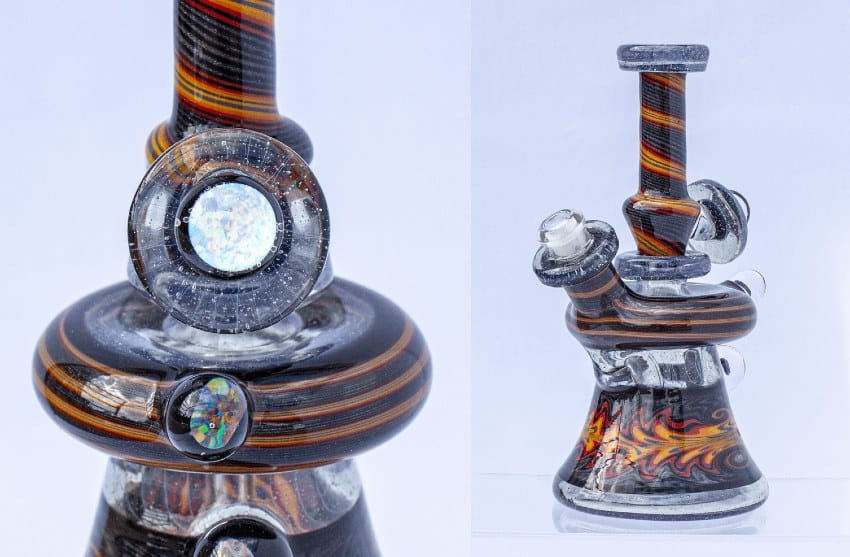
Updated in April 2022
Our online smoke shop carries a range of stunning and locally made heady glass. If you’re new to the head shop scene, or looking to better understand your options, review our expert guide to learn the essentials of heady glass.
What Is Heady Glass?
Before exploring the topic further, it’s important to understand what “heady glass” is exactly, and what sets it apart from other pipes, bongs and dab rigs. The term “heady glass” refers to high-quality glass crafted by glassblowers into one-of-a-kind works of art. Heady glass pieces are carefully crafted by glassblowers, using alluring colors and intricate detail to form each quality product.
Some glass pieces prioritize ease of use and functionality exclusively without much attention to aesthetic appeal – often referred to as “scientific glass.” The artistic glass market has skyrocketed over the past several decades, and as time goes on, the two distinct categories of scientific glass and heady glass have become increasingly intertwined. Today’s heady glass devices and smoking accessories are pleasing to the eye without sacrificing function and longevity.
Functional Glass or Not?
Hand pipes and water pipes are known as “functional glass,” since they can be used to serve a purpose beyond their visual appeal. “Non-functional glass” exists only as a work of art or decoration without the potential for use as a tool. Heady glass pendants are a popular form of non-functional glass with millenniums of celebrated history.
Glass pipes, hookahs, dab rigs and similar devices comprise a large percentage of the functional glass market. With the legalization of cannabis and the advent of social media, the widespread visibility of functional glass products have skyrocketed over the past decade. Glass artists in Denver and worldwide have brought their unique skill and flair to glassblowing for thousands of years, causing heady glass to evolve and improve to the exceptional pieces available for sale in head shops today.
Pricing Heady Glass
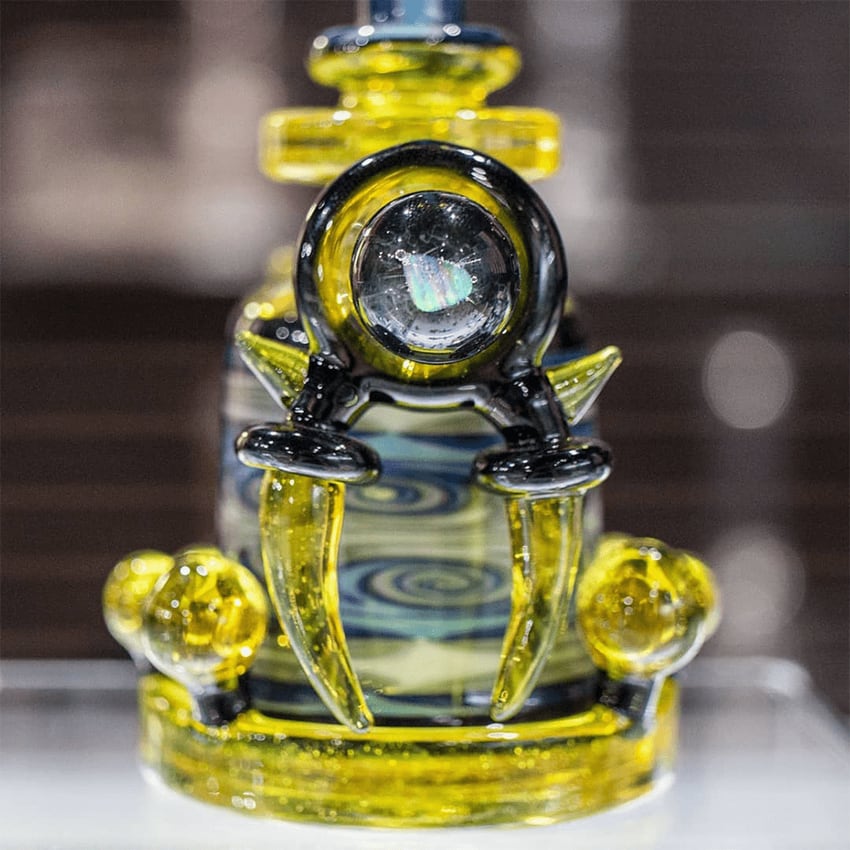
Heady glass prices range significantly. While 710 Pipes carries heady glass pieces for every price range, many intricate and highly-demanded pieces on the market today cost thousands of dollars. Many shoppers are shocked by the price of high-end heady pieces. However, this valuation is standard for several reasons. Glassblowers contribute countless hours of training and intensive labor to every piece of heady glass – not to mention the cost of materials and investment in equipment.
Supply and demand largely dictates the prices of virtually every product out there. Collectors, critics and gallery owners may invest thousands on a variety of breathtaking or unusual pieces – and intricately crafted glass is no exception. Thanks to social media, exceptionally talented glassblowers can promote their work more easily, and market specifically to interested shoppers and art-lovers alike. Top artists can slowly gain an online following, often increasing their prices as their notoriety grows.
Tips for Buying Heady Glass
A quality heady glass piece will work well and last for years. However, most of us aren’t made of money (our team included) so sinking our hard-earned cash into a heady piece shouldn’t be taken lightly. Before choosing the perfect heady glass piece, consider these factors:
- Know Your Artist – Thousands of glassblowers have heady glass available for sale. Before making a big purchase, it’s worth looking into the artist who made your piece. Finding a reputable craftsman with pieces that fit your style will always pay off. Our team did the heavy lifting for you by collecting pieces exclusively from trusted and exceptionally talented local glassblowers to sell in our online head shop and three Denver-area locations.
- Try Before You Buy – In you’re shopping at our local shops, feel free to ask our team members for a preview of your heady rig, hookah or pipe in action. Artists tend to go above and beyond with cool features that can’t be appreciated ’til your glass is in use. Feature demonstrations of our latest heady pieces are often available on our Instagram.
- Handle Heady Glass with Care – Some artists and head shops include protective casing for heady glass pieces, to ensure that they don’t break before you make it home. Fragile products sold through our online smoke shop are wrapped well and handled delicately so they make it safely to your doorstep.
How Is Heady Glass Made?
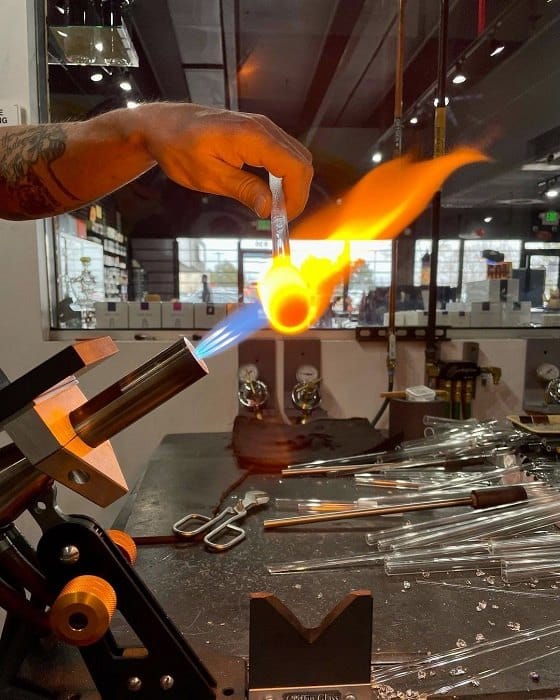
If you’re a smoke shop regular, you’re likely to appreciate the art of well-crafted heady glass pieces. It’s impossible not to respect the intricacy and vision in exceptional glass pieces by talented glassblowers on the market today. When you’re marveling at the works of Denver legends like Hedman Headies, Mycomann, 2 Kind Glass and more, you may find yourself wondering exactly how these works of art are made. Read on for a closer look at the process of heady glass creation with a step-by-step review of the standard glassblowing process.
Glassblowing Terms to Know
Furnaces used to form vases, sculptures and heady glass pieces contain several components which are crucial to the glassblowing process. These include:
- The Crucible – a ceramic or metal portion of a furnace, designed to hold glass, metals and other substances as they’re heated to the point of liquifying.
- Annealing Oven – this component is used to heat glass or metal to extreme temperatures, altering the microstructure of either material to make them malleable before cooling and re-solidifying.
- Glory Hole – a hole in the side of a furnace, used to access and shape molten glass by artists while it’s malleable.
Getting Started
At the start of the glassblowing process, artists reach into the furnace with a steel blow pipe through the furnace’s glory hole with a long, steel rod. They roll the end of the rod against the melted glass to collect it in a cylindrical formation. From there, artists remove the pipe from the furnace and slowly move the malleable glass to a specialized steel table called a marvel. Next, they rotate the rod against the marvel in a slow, constant motion to shape it evenly. Glass needs to remain at 1000 degrees Fahrenheit or higher to remain malleable. To maintain this temperature, artists make several trips back and forth to the furnace, returning their work in progress to high temperatures through the glory hole, then rolling it against the marvel until the piece is sufficiently and evenly shaped.
Color and Design
Entirely transparent bongs, pipes and hookahs have their place in our hearts – but artists usually opt to add color to their heady glass creations. Using powders, bars and frits, artists elaborately design their pieces with unique combinations of shape and color. They’ll generally place these substances against the marvel and roll their piece against with the same steady motion, returning to the glory hole to fully blend and adhere any added elements into the piece itself.
Glassblowers then rest the rod against the steel arms of their bench. They continue to rotate the rod slowly with one hand, and use the other to shape the piece more intricately. This is done with a unique combination of tools – potentially including wooden paddles, wet newspaper, and stainless steel equipment. This stage requires artists to coordinate the motions of their hands quite carefully – and if they succeed, this stage lets their piece take shape into any elaborate formation of the artist’s choosing.
While glassblowers craft the shape and structure of their developing heady glass, they may return to the previous stage repeatedly to add more clear glass elements or layer in additional color.
Shifting Gears (and Rods)
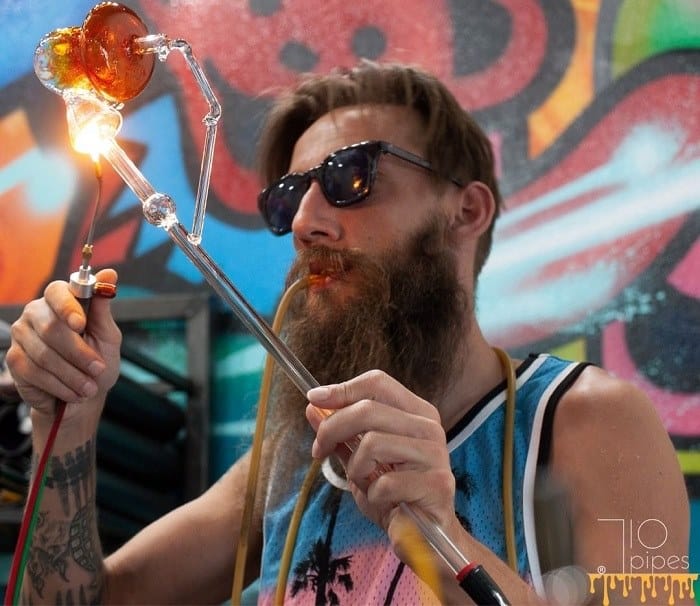
From here, the literal glass blowing starts. Artists exhale through the hollow steel rod, creating a bubble within the glass before continuing to heat and rotate the piece through the glory hole. They’ll make several more trips back and forth from the bench to the furnace as their heady glass slowly takes shape.
Once the artist is satisfied with the piece’s shape and color, they’ll move the piece to another steel pipe, heating over flames throughout the prior stages. This new pipe is known as a punty. The transfer from the blow pipe to the punty allows glassblowers to form openings in their glass and form a stable base for larger heady glass pieces. An assistant will collect a small amount of clear, molten glass from the furnace onto the punty. The artist will then sit on the bench and stop rotating the blow pipe, while the assistant touches molten glass at the end of the punty to the piece. The artist must choose the right moment to wrap the blow pipe and break it away from the piece, leaving it solely attached to the punty.
This step is especially risky – it’s easy for the piece to drop mid-transfer and shatter – often rendering the time and careful effort up to this part of the process wasted, and setting the artist back to square one.
If the transfer was successful, the piece is heated once more through the furnace’s glory hole at the end of the punty. They can perfect the shape of their developing glass in this final stage using the tools described above and more.
Here Comes the Drop
Finally, the glassblower must remove the piece from the punty. They position the glass piece above a box filled with layers of fire-proof blanket – then firmly hit the punty so the attached piece drops into the box below. The artist then uses Kevlar gloves to pick up the scalding piece and place it carefully into the annealing oven. The oven is originally set to a temperature of 960 degrees Fahrenheit, and gradually cooled to room temperature over the course of approximately fourteen hours. By gradually cooling their heady glass, artists can usually prevent unwanted effects of extreme temperature shifts like cracks in the piece’s exterior. Sometimes they open the annealing oven to unwanted surprises – but if all goes as planned, they’re greeted by a stunning and intact heady glass masterpiece.
See Live Glassblowing Our Northglenn Smoke Shop!
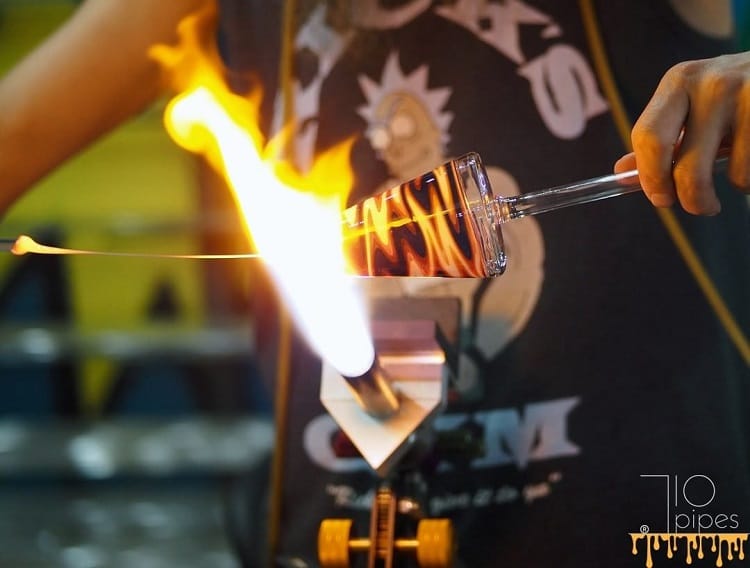
As you can see, the art of glassblowing isn’t for the faint of heart! Glassblowers in Denver and beyond must have the perfect blend of creative vision, dexterity, patience – and perhaps most importantly, serious patience. We’re incredibly proud to know more than our share of gifted glassblowers in the Denver area and keep hundreds of their best heady glass in store – including exceptionally crafted water pipes, dab rigs and hookahs. Legal adults anywhere in the U.S. can choose from hundreds of top-quality heady glass pieces 24/7 for delivery straight to your door. If you’re in the Denver area, visit us in person at our three area shop locations! Stop into our Northglenn smoke shop daily from 11AM-8PM, or find our Evans Avenue smoke shop in the heart of Denver, within walking distance of Denver University. D.U. students get 10% off with a valid student ID!
Whether you’re shopping online or onsite, 710 Pipes is proud to provide you with the very best pipe shop products on the market today.
